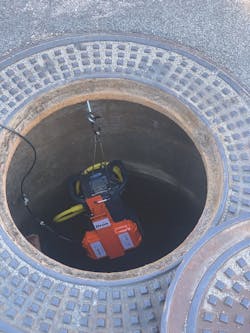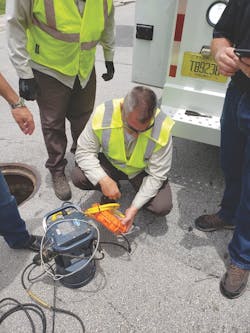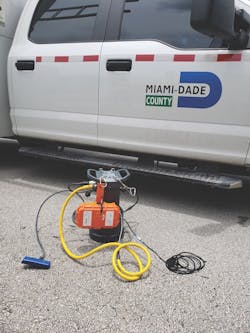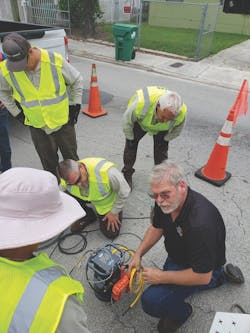Smart SSO Sensors: Building More Resilient Cities
Itai Dadon is global head of smart cities for Itron. Mark Serres is chief technology officer for Utility Systems Science and Software. Dadon and Serres can be reached by emailng Meghan Witthaus at [email protected].
undefinedThe number of disasters worldwide has more than quadrupled from 1970 to around 400 per year, according to the United Nations. The influx of extreme weather events combined with increased urban development in recent years has put significant pressure on utilities to manage wastewater and sanitary sewage overflows better.
Sanitary sewer overflows (SSOs) can occur when the flow rates through the sanitary sewer system exceed the pumping capacity. This can result from a range of causes such as blockages, sewer line breaks, power failures, improper sewer design, tampering with the system and most prevalently, sewer defects that allow storm water and groundwater to overload the system, otherwise known as inflow and infiltration (I&I). In many cases, I&I accounts for up to 45% of the annual flow to treatment plants.
SSOs can contaminate public parks and waterways, cause property damage to residents and businesses and threaten public health. Due to these risks, SSOs are prohibited by the U.S. EPA unless authorized by a National Pollutant Discharge Elimination System (NPDES) permit. The EPA also places strict limits on the use of pumping stations to no more than 10 hours at a time to reduce the risk of failure.
The EPA estimates there are between 23,000 to 75,000 SSOs per year (not including sewage backups into buildings) in the U.S. The penalty can involve a fine of $50,000 or more per incident or if deemed necessary by the EPA or a consent decree.
Common Reasons for SSOs
Many utilities struggle with SSOs, resulting from a combination of increasingly common issues for cities. Just a few examples include:
- Real estate developments where utilities tie their gutter system into the wastewater collection system, which are illegal interconnection points for inflow;
- Resident, property owner, developer, facility manager struggles with standing water that regularly collects after rain events, and as a result, requires modified drainage systems with non-permitted catchments or interconnections with the public wastewater system;
- Urbanization increasing the amount of pavement and other non-porous building materials, which creates more water runoff leading to more overflows; and
- Pipes that crack due to age or intrusion from roots, allowing water to seep into the wastewater pipes when the water table rises.
These issues are exacerbated by increasingly frequent natural disasters and the planet’s warming climate, which put additional pressure on utility wastewater systems in addition to rising sea levels increasing the water table and more frequent heavy
rain events.
Pitfalls of Traditional SSO Monitoring
Utilities must monitor flow rates at key locations to prevent the overuse of the wastewater system. If the sensors used for this are not connected, this process requires manually retrieving data logs, which is further complicated by traffic since field crews can spend significant time traveling between measurement sites.
The traditional approach to measurement requires monthly site visits and often requires shutting down an entire street or intersection, which can potentially cause traffic problems and other public safety issues. Problems may occur with measurement devices, causing inaccuracies or even a complete lack of visibility. Finally, measurement typically is a hazardous task for the field crews due to the velocity of wastewater flow. The danger of falling requires extensive safety precautions because the risk of death is significant.
Smart Sensors for Near Real-time SSO Monitoring
One utility has demonstrated its commitment to assessing, rehabilitating and improving its wastewater collection system and pump stations to address these challenges. Miami-Dade County partnered with Itron and Utility Science, Systems and Software (US3) to create a solution, which includes smart sensors from US3 and data visualization tools available through Itron’s developer program to create customized data dashboards. With near real-time visibility at key locations in its distribution network, the utility can address regulatory concerns by pro-actively identifying conditions that cause sewer overflows.
This solution automates the measurement of flow rates at key pumping stations, effectively eliminating the lengthy and dangerous manual process that has traditionally been employed. The data can then be used for capacity analysis and performance monitoring for sanitary sewers to improve optimization. Also, having remote access to sensor data allows the utility to identify inaccuracies or failures from measurement devices, which ensures the integrity of the information collected.
Granular Wastewater Flow Data
Still, in its early days of full deployment, Itron’s data analytics tools have given Miami-Dade enhanced visibility into wastewater flow monitoring, which will equip the utility to sense and mitigate sewer overflows to reduce the public health risk. The solution will also significantly reduce the operating costs and labor requirements associated with the traditional measurement method and prevent truck rolls through automation and remote monitoring. This means Miami-Dade will be able to immediately access more data in near real-time to identify an issue. Additionally, the data are more granular than what was able to be collected manually and thus will give Miami-Dade more sophisticated analysis and pattern matching to pinpoint the root cause of an issue and map a resolution.
This technology is becoming an important element of Miami-Dade County’s Water and Sewer Operations Program. It was created to fulfill the department’s vision of continuous delivery of high-quality drinking water and wastewater services in compliance with all regulatory requirements. This aimed to be completed by enhancing water and sewer infrastructure with smart sensor technology over the next two decades. The program investment is estimated to create $24.9 billion in economic output and create 17,0000 new jobs in the next decade alone.
By adopting advanced technologies from Itron and US3, utilities like Miami-Dade County can take meaningful steps towards mitigating risks to the safety of the public and the environment.
As urbanization shows few signs of slowing down, and hurricanes and flooding become more extreme, advanced connected sensors, automation and analytics are quickly becoming a critical means of maintaining compliance and preventing issues before they arise. Not to mention these technologies enhance public safety, especially for the men and women who put themselves at risk to keep our water safe.
Different utilities can face slightly different challenges. Each has its own set of issues created by factors such as geography, population, age of infrastructure and more. The partnership between Miami-Dade, Itron and US3 enabled critical advancements in the utilities space to help solve issues in a way that was tailored to the specific needs of that location.



